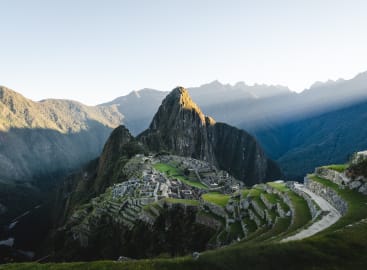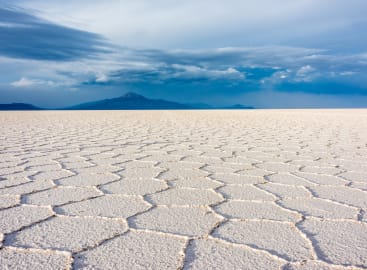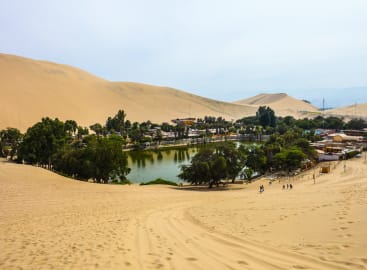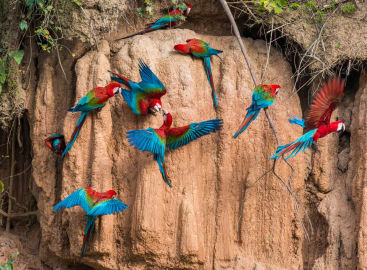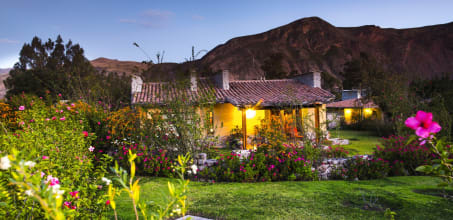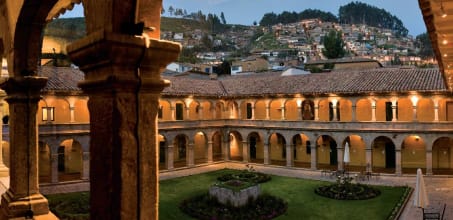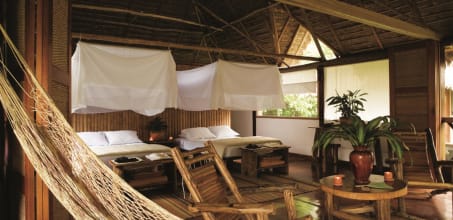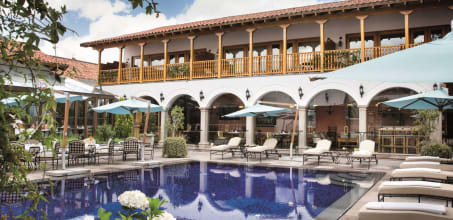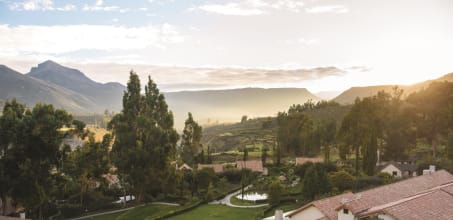Luxury Peru Holidays 2024/2025
Combining a fascinating history and vibrant culture with beautiful natural landscapes and scenery, Peru is one of Scott Dunn’s most enthralling destinations.
- Bespoke Peru travel tailored to you
- Expert on-the-ground knowledge providing exclusive access to unique experiences
- Seamless service with 24/7 support
- Peru holidays from award-winning luxury travel experts

For a first-time Peru holiday, we recommend exploring the thriving city of Lima, where modern and ancient Peru meet. Here you can choose between visiting local museums, basking on glorious beaches or sampling gastronomic wonders at some of the best restaurants in South America. To discover Peru’s rich Inca heritage, pair your visit with a trip to Machu Picchu, taking in the Sacred Valley and the captivating city of Cusco on your way.
The Peruvian Amazon is another must-visit destination, ideal for those seeking an adventure-filled break. From trekking through the lush jungle to catching sight of colourful birds and exotic animals on a luxurious Amazon river cruise, a trip to the rainforest is a truly unique experience.
At Scott Dunn, our travel experts will use their insider knowledge to help you find your perfect Peru holiday destination. So, whether you’re planning an epic solo adventure or a summer break with your family, get ready to enjoy the holiday you’ve been waiting for.
Best Tours in Peru
Ready to learn about the historical sights of Northern Peru? Or perhaps you can’t wait to discover ancient ruins on a Machu Picchu holiday, guided by a passionate local. Our travel experts have curated a series of itineraries and tours that will allow you to explore Peru’s travel highlights at your own pace. With a range of short excursions and longer tours to choose from, there’s something for everyone to enjoy at Scott Dunn.
Top Luxury Hotels in Peru
At Scott Dunn, we’ve tried and tested countless hotels so we can help you find the very best accommodation for your luxury Peru holiday. Embrace rich historical beauty at a boutique hotel in the oldest cities in the country or reconnect with nature at a rustic jungle lodge in the rainforest - the choice is yours.
Key information about Peru
- Best time to visit: May to September
- Average flight time: 15.5 hours
- Time difference: -5 hours GMT (-6 during British Summer Time)
- Currency: The Sol
FAQs About Luxury Peru Holidays
-
The best time to visit Peru largely depends on the experiences you want during your trip. Here are a few things our experts recommend you consider.
The dry season, from May to September, is generally considered the best time to visit Peru. The weather is drier, making it ideal for trekking to Machu Picchu or exploring other regions like Cusco, the Sacred Valley and Lima. However, keep in mind that this is the peak tourist season, so popular attractions are more crowded.
The shoulder season, April and October, marks the transition between the wet and dry seasons. They offer a balance between fewer crowds and relatively good weather. April is a good time as the landscape is lush after the rainy season.
November to March is the rainy season, and while it might not seem ideal, it has its perks. The landscapes are incredibly green and vibrant and there are fewer tourists. However, heavy rains can affect travel plans, especially in more remote areas or during treks.
If you're interested in cultural experiences, consider visiting during festival times. The Inti Raymi festival in Cusco (June 24th) celebrates the Incan sun god and includes colourful processions and reenactments. Semana Santa (Holy Week before Easter) is also celebrated with fervour in various cities, particularly in Cusco.
-
Peru is an incredibly diverse country with a wide array of destinations and many incredible things to see and do here. Here are our top recommendations.
Undoubtedly, one of the most iconic and awe-inspiring attractions in Peru is a Machu Picchu holiday. Taking the Belmond Hiram Bingham train is a once-in-a-lifetime experience, with delicious food and on-board entertainment, and is a great way to arrive or depart from Machu Picchu. For something truly unique, stay at Belmond Sanctuary Lodge and be one of the first visitors of the day with 6am slots at Machu Picchu. At Lake Titicaca, stay at the hotel Titilaka, which partners with local indigenous communities like the Uros who live on floating islands made of reeds. Through their partnerships, they can offer exclusive and intimate tours of the floating islands to their guests that are unavailable to other travellers.
Peru is also an up-and-coming spot for culinary enthusiasts, and home to some of the world’s greatest chefs and restaurants. In Lima, guests can participate in a private gastronomic tour, where they can eat their way through the city’s delicacies and end the tour enjoying lunch in front of the Huaca Pucllana ruins.
-
Our holidays to Peru involve a long-haul flight, so we recommend at least a week to give yourself time to adjust and take in all this country has to offer.
If your main goal is to see Machu Picchu, we suggest about 7-8 days as the minimum, in order to give yourself time to acclimatise to the higher altitude before visiting the ruins. During this time, you will enjoy a few days in Lima, head to the Sacred Valley, spend 1 night in Machu Picchu, and finish the trip with a couple nights in Cusco.
If you would like to visit additional destinations in Peru, such as the Amazon, Colca Canyon or Lake Titicaca, please give yourself an additional 2-3 days per destination. If you have the time, Peru can also be perfectly paired with Ecuador or a trip to the Galapagos Islands for amazing wildlife, or you can head south to Bolivia for some incredible scenery.
-
The best way to visit Machu Picchu is to take the train from Cusco to Machu Picchu and spend the day exploring the ancient city before taking the train back down at the end of the day. Some buses will take you to the top, however, they’re often crowded. Plus, the train offers a more comfortable ride with on-board food, drinks and entertainment.
We’ll arrange all of this for you before you go though, so you can explore Machu Picchu with ease.
If you’re interested in hiking the Inca trail to Machu Picchu instead, our travel experts are on hand to answer any questions you may have. Do note the hike takes 4 days and is not recommended for families with small children.
-
While Machu Picchu holidays may dominate the headlines for Peru, this country is bursting with cities waiting to be explored. Here’s what our Peru expert Eli Hardcastle had to say about her favourite spots.
“Peru’s capital Lima is an incredible destination for foodies. Whether that means a 12-course dinner at Central (just voted #1 Best Restaurant in the World), a private gastronomic tour or cooking class, it is a paradise for those who enjoy top-notch food.
Situated on the shores of Lake Titicaca, Puno offers a glimpse into the indigenous cultures of the Andes. Visitors can explore the lake's islands, including the famous floating Uros Islands. Located in the heart of the Amazon rainforest, Iquitos is the gateway to exploring the jungle. Visitors can visit the Amazon by luxury cruise or lodge, and they can expect to visit indigenous communities and experience the incredible biodiversity of the Amazon.
Arequipa, known as the "White City" due to its buildings made of white volcanic stone, is a popular choice for somewhere with more time to dive deep into Peruvian cities. Surrounded by stunning volcanoes, its historic centre is a UNESCO World Heritage site, and nearby attractions include the Colca Canyon, a great spot for viewing Andean condors.”
-
Peru boasts incredible biodiversity and a wide variety of ecosystems, making it a paradise for nature and wildlife enthusiasts.
The most common and obvious place to discover wildlife is in the Amazon Rainforest. Expect to see diverse bird species, monkeys (like howler monkeys and capuchins), sloths, caimans, anacondas, colourful insects and various plant species. Just 4 hours driving from Lima, you can visit Coastal areas such as Paracas National Reserve, which are rich in marine life. Take boat tours to see colonies of sea lions, Humboldt penguins and various seabirds. The Ballestas Islands, known as the “mini-Galapagos of Peru” are particularly famous for their wildlife.
Lake Titicaca, the highest-altitude lake in the world, offers incredible scenery of the lake and the man-made floating islands, as well as some unique species like the giant Titicaca water frog and several bird species like the Andean goose. Visitors to the Colca Canyon near Arequipa can expect magnificent views of the canyon on the surrounding volcanos and can often spot the majestic condor flying through the sky.
-
Peruvian cuisine is renowned worldwide for its diverse flavours, fusion of cultural influences, and use of fresh, high-quality ingredients. Due to their proximity to the Pacific Ocean, seafood, and ceviche in particular, is very prolific in Peruvian cuisine. For those who enjoy a cocktail, the Pisco Sour is the most iconic drink in Peru. When staying at Palacio Nazarenas in Cusco, your own personal butler will be happy to prepare a fresh Pisco Sour for you, or even teach you how to make your own.
In terms of experiencing Peruvian cuisine, here are a few suggestions from our Peru travel experts:
- Local Markets: Visit local markets like Mercado San Pedro in Cusco or Mercado Surquillo in Lima to sample fresh fruits, street food and regional specialties.
- Fine Dining Restaurants: Lima especially has an exceptional dining scene with renowned restaurants like Central, Maido and Astrid y Gastón, offering innovative interpretations of Peruvian cuisine.
- Cooking Classes: Participate in a cooking class in Lima to learn how to prepare traditional Peruvian dishes.
- Street Food Tours: Take a private guided tour in Lima focused on street food to sample a wide variety of authentic dishes from local vendors.
-
To start planning your Peru family holiday, get in touch with our travel experts who will build a bespoke itinerary perfect for your family.
Prefer activities planned for the whole day? We’ll make sure your days are filled with engaging experiences without overdoing it. Want some free time instead? We can offer recommendations for things to do and you can go off and explore at your own pace.
Whether you’re travelling with younger kids, older ones or grandparents, we know the best hotels to keep the whole family happy and create a trip that allows everyone to experience Peru at its best.
-
Altitude sickness can affect travellers visiting high-altitude destinations in Peru, especially places like Cusco, Machu Picchu and the Sacred Valley, which are situated at elevations above 2,400 meters. Here are some tips to help prevent and manage altitude sickness:
- Acclimatise: Take it easy when you first arrive at high altitudes. Allow your body time to acclimatise by spending a day or two at a lower altitude before ascending further. We typically will have our guests stay in the Sacred Valley for 2-3 nights before heading to Machu Picchu, and we do our best to keep their first day at the higher altitude as relaxed as possible.
- Stay Hydrated: Drink plenty of water to stay hydrated. Avoid alcohol and limit caffeine intake, as they can contribute to dehydration.
- Medication: Some travellers find relief with medications like acetazolamide, which can help prevent and alleviate symptoms of altitude sickness. However, consult with a healthcare professional before taking any medications.
- Coca Tea: Coca tea, made from the leaves of the coca plant, is a traditional remedy in Peru believed to help alleviate altitude sickness. However, be aware of local regulations and use it in moderation.
- Oxygenated rooms: In Cusco, we can offer oxygenated rooms to guests who are particularly worried about altitude sickness. These rooms pump a constant flow of fresh oxygen in, compensating for the lower levels of oxygen at higher altitudes. At Belmond Palacio Nazarenas, all rooms are oxygenated.
-
Peru is a casual country, so no need to worry about fancy evening wear (unless you plan to go to a nice restaurant in Lima or Cusco). When preparing for a Peru holiday, especially considering the varied climates and activities, here are some staple items and clothing suggestions:
- Layered Clothing: Peru's diverse geography means varying climates. In the highlands (Cusco, Machu Picchu), layers are crucial. Bring thermal base layers, long-sleeve shirts, sweaters and a waterproof jacket or poncho. Evenings can get cold.
- Comfortable Walking Shoes: Whether exploring cities, hiking trails or archaeological sites, comfortable and sturdy walking shoes are essential.
- Sun Protection: Peru’s sun is strong at high altitudes. Pack a wide-brimmed hat, sunglasses, and sunscreen (with a high SPF) to protect against the sun's rays.
- Insect Repellent: Especially important if visiting jungle areas like the Amazon, where mosquitoes can be prevalent.
- Adventurous Gear: For those booking adventure activities like trekking or jungle tours, consider packing quick-drying clothes, a good backpack, moisture-wicking socks, and possibly trekking poles.
- Swimwear: If you're planning on visiting coastal areas or the Amazon, or using hotel pools, don't forget your swimwear.
-
There are no additional vaccinations required for travelling to Peru outside of those already required and recommended by the UK government.
There is a risk of yellow fever in some areas of Peru, specifically if you’re visiting the Amazon. However, if you’re above the 2,400m altitude mark, like in Cusco, Lima and Machu Picchu, then the yellow fever vaccination is not recommended.
You can learn more on the Government-recommended health travel website.
-
British citizens do not need a visa when travelling to Peru for tourism purposes or short visits. However, you must have at least 6 months on your passport before its expiry date from the date you arrive in Peru, not the date you book.
For more information, check the government website for foreign travel advice.
-
Most of our holidays to Peru start in Lima, and there is a direct flight between London and Lima with LATAM, however, there are frequent indirect options as well. There are flights with Iberia Airlines, which connect via Madrid, as well as KLM.
-
The best way to get around Peru is via domestic flights or private transfers. There are some train options as well, however, we recommend flights to save some time.
We’ll arrange all private transfers, trains and flights for you before your trip so you can explore the country with ease.
-
Our luxury Peru holiday tours start at around £6,100 per person and can go up to £13,000 per person or more depending on the final itinerary.
You’ll have a complete view of costs during the entire planning process, from hotels, experiences, flights and whatever else we can arrange for you, so you’ll know the exact cost before booking.
-
To book a holiday tour to Peru with Scott Dunn, get in touch by calling us at the number listed below or filling out our online enquiry form.
Why choose Scott Dunn for Luxury Peru Holidays?
Unique to You

- We listen to your travel goals and craft unique trips that are bespoke to you.
- We’re with you every step of your life’s travel journey, from honeymoons to family trips and beyond.
Seamless Service

- Global offices in the UK, US, and Singapore for 24/7 seamless service.
- We offer flexibility if your plans change so you can book with confidence and peace of mind.
Carefully Curated Collection

- We’ve curated an elevated collection of accommodation, experiences, and guides.
- Committed to fostering close global relationships to continue bringing you unique experiences.
Luxury in Every Sense

- We deliver a sense of luxury that matters most to you.
- Awarded Condé Nast Traveller’s Top Travel Specialists in the World 10 years in a row.
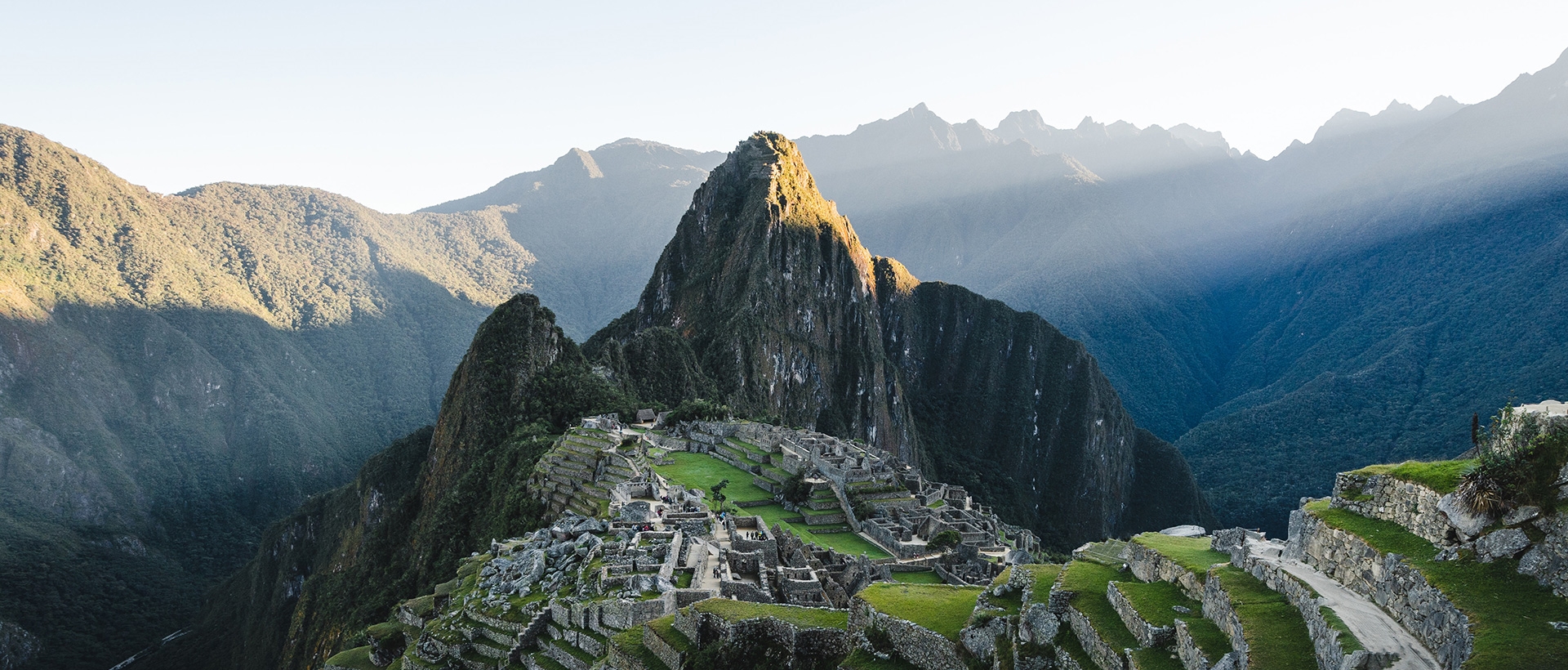
Our team of travel specialists are waiting to help you book your next adventure.
Explore Our Expert Travel Guides

From the exhilarating sight of Machu Picchu to exploring the immense waters of Lake Titicaca and soaking up the ancient culture of the Incas, your family holiday to Peru will leave you with incredible memories to last a lifetime.

With its thriving culture and endless opportunities for adventure, Peru is an incredible place for a family holiday with teens in tow.

Sister boats Delfin I and Delfin II offer one of the most exclusive and glamorous ways to enjoy the Amazon in all its grandeur with 3 and 4 night expeditions into the extraordinary Pacaya Samiria National Reserve.
